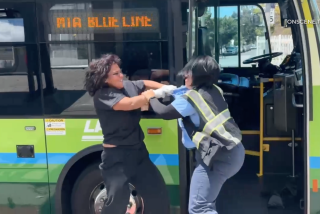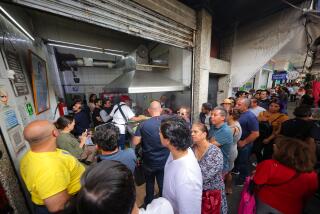Mexico City’s microbuses offer cheap thrills and spills
You throw your hand in the air, and the groaning beast, resembling a banged-up bread box, slows to let you board, but never really stops. You press coins into the driver’s palm and grab quickly for a hold before he guns the motor to continue his breakneck run across Mexico City.
Hang on — you are passenger, and captive.
Life in this hive of 20 million people is much about movement. There are subways, fast-lane buses, light-rail trains, far too many cars and taxis and a small but encouraging number of publicly lent bicycles for the stout-hearted.
But no part of the transit grid captures Mexico City’s air of barely checked catastrophe quite like the little buses known as micros.
Painted green and white, pug-nosed and as scarred as old brawlers, the 28,500 micros (pronounced MEE-crows) are blessing and bane: cheap and frequent but often operated as if in a demolition derby.
On weekdays, the privately owned micros ferry a whopping 12 million passengers, or nearly triple the number carried by Mexico City’s huge subway system.
Riders, carried a dozen or two at a time, are mechanics, street vendors, maids, waiters, clerks and the millions of others who must navigate broad stretches not covered by the subway or public buses. Fares are as low as 3 pesos, less than 25 cents, one reason micros often have passengers hanging from the doors.
But they can be the biggest boors on the road. They shoulder their way through traffic, sometimes at terrifying speeds, then brake suddenly to take on riders, even in the middle of an intersection. Their collisions are a familiar feature of Mexico City tabloids.
Government figures recently published by the Excelsior newspaper showed that nearly two in five micros crash at least once per year. Another newspaper, El Universal, found that 83% of their passengers don’t feel safe.
It’s easy to see why.
Many of the older vehicles, converted cargo vans, are rusting crates with improvised bench seats, holes in the floor and wires sprouting from the dash.
Passengers fold themselves into the cramped rows or stand, packed like upright sardines, gripping overhead bars as the bus weaves and lurches. Tall passengers have to stoop.
Drivers, some of whom look to be barely out of junior high, slouch in jury-rigged seats and blast music while they try to outmaneuver one another over the next handful of change. The aging vehicles run through red lights, flapping and creaking.
A micro driver was jailed last month after his vehicle crashed on the city’s southern flank, killing eight people and injuring 20. Survivors said he was racing.
Two weeks earlier, a micro plunged over an embankment, leaving 10 people dead and 17 hurt. On Dec. 3, a bus believed to have been speeding crashed into a tree, injuring 10 passengers and the driver.
Passengers will scold an especially wild driver, but mainly they just hang on and hope for the best. I’ve used the rattletrap micros hundreds of times and never seen a crash, though I wince and brace regularly.
Crime is a problem too. Although Mexico City’s taxis are notorious, micros register twice as many robberies, Old West-style stickups by armed bandits who hop aboard and make riders empty their pockets. Often, the bus keeps rolling until the robbers jump off, leading many to suspect driver complicity.
Transit specialists say lax oversight and the pell-mell chase for fares leave micro passengers at the mercy of driver whim.
“There is no protocol,” said Roberto Remes of the nonprofit Institute for Transportation and Development Policy. “You have every incentive for bad behavior.”
He and other critics say the microbuses should be scrapped for an expanded public bus network.
That’s happening, poco a poco. Mexico City Mayor Marcelo Ebrard has sidelined 4,000 micros — replacing them on key arteries with sleek, air-conditioned buses — and wants to get rid of 5,000 more.
But micros aren’t going away soon, meaning the best approach may be to hang on and hope for the best. After all, many of the drivers are competent, and even the thumping soundtrack can offer escape after a taxing day.
More than that, commuting by micro provides a window on the intimacies of a hurried megalopolis: Office girls applying morning mascara between pothole bumps. A man in worn dress slacks clutching a folder of red-tape headaches. Shaggy-haired teens nuzzling in imagined privacy.
It can be fun to watch rider reactions to radio chatter, like the rolled eyes that greet a government radio spot touting victories over drug cartels.
And during a jampacked rush-hour run, when knapsacks jab kidneys and passengers spill from the doors, you can savor the unintended irony of a sign posted in many micros.
It says to exit through the back, please, because that’s what polite riders do.
More to Read
Sign up for Essential California
The most important California stories and recommendations in your inbox every morning.
You may occasionally receive promotional content from the Los Angeles Times.









